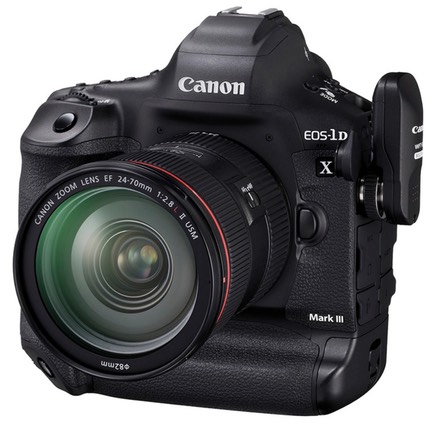Just prior to showing it at CES—!!!, this is not a consumer camera—Canon officially launched the EOS 1DX Mark III, the long-expected sports/PJ camera replacement at the top of their DSLR lineup. We'd previously gotten vague pre-announcements from Canon, including some prototype camera and feature teasing at Photo Expo back in October.

So what is the same and what's different in the new 1DX?
Let's start with the same, even though much of the "same" has small changes to it. The body and power for the 1DX doesn't change. Same body size and shape and viewfinder for the most part, and same LP-E19 battery (2850 shots CIPA, four hours video recording). Some little things change on the body, though, such as backlit buttons (ala Nikon's), and a new AF-ON button that allows you to position the focus cursor by sliding your thumb on it. A 1DX m2 shooter is going to migrate to an m3 in an eye blink for the most part and not notice much different.
The sensor did and didn't change. It's still 20.1mp (5472x3648). But it appears that Canon has been tweaking the bandwidth and making a number of small improvements to image quality. The new sensor also has full dual pixel autofocus capability, which comes into play in Live View and video recording. Sitting over the sensor is a new AA (low pass) filter technology, which Canon claims is "high detail.
The dual pixel autofocus array covers the entire sensor (90% actual coverage in Live View), which gives the 1DX m3 a bit of a dual personality when it comes to autofocus. In DSLR mode, the focus positions bump up to 191 (155 cross point, with a dual f/2.8 cross point at the center) and a -4EV focus range. All the usual 1DX focus settings are there and have been slightly tweaked, and there's now subject recognition in the base system, using a machine learning system. In Live View (and most video modes) the new camera switches to the dual pixel sensor capability, with up to 3869 selection locations (more typically you'd use 525 zones), and all the R mirrorless-type focus capabilities.
The sensor bandwidth changes show up big time on the video side. Not only does the 1DX m3 record a no crop 4K—UHD or DCI—with 4:2:2 video recording internally at 24, 25, 30, 50, and 60P, but a full 5.4K raw option is also available for internal recording. 1080P goes to 120 fps.
Given that Canon has picked some fairly bandwidth intensive video levels (940Mbps All-in for 4K DCI), you'd probably also expect faster storage. Here Canon has finally seen the error of their ways in believing what SanDisk was telling them to do and has come back fully to embrace the CompactFlash standards committee. Nope, that doesn't mean CompactFlash cards, nor SanDisk's disastrous CFast alternative. It means that Canon is now the fourth company of the majors to endorse CFexpress Type B. The camera gets two such slots. And Canon themselves will be selling CFexpress cards, at least in some markets. Initial shipments of the 1DX m3 will come with a single CFexpress card and a card reader.
The results are impressive for still shooters: 1000+ frame buffers (with the right card) whether you're shooting JPEG, raw, or raw+JPEG. If you select HEIF, you'll see some slowdown (raw+HEIF results in about a 350 shot buffer). Wait, what's HEIF? That's the native file format of the iPhone and a new 10-bit format standard that's poised to replace/supplement JPEG in the future. Frankly, this was a good choice by Canon: having 10-bit images available straight out of camera means that the photo editor you're sending images to has a bit more flexibility in doing final adjustments before publication (at least if they have software that understands HEIF, like Apple Photos or Photoshop). Another benefit: Canon records HDR shots into those extra bits of HEIF.
For connectivity we get 802.11b/g/n Wi-Fi (2400MHz), Ethernet 802.3u (1000Base-T), Bluetooth 4.2, USB 3.1 Gen 2, and GPS built in. An optional faster, longer range Wi-Fi option is also available.
The full list of 1DX Mark III specs is available elsewhere on this site, so I won't go further in detailing the changes here.
The big question is whether or not Canon has done enough to retain the kind of shooter that's going to show up at the Tokyo 2020 Olympics with a full kit. I'd tend to say yes, this was just enough. If nothing else, the lifting of the buffer constraints and the flexibility to do 20 fps silent shooting would have been probably enough to retain the truly faithful. But the focus performance is certainly better, and it'll be interesting to see what the new AA filter and sensor tech provides in terms of image quality.
Additionally, the 1DX just became a real workhorse video camera. While DPAF isn't available for the internal raw or 60 fps 4K options, it is for the rest of the video capabilities. We've got headphone and mic jacks, and some pretty decent compression bandwidth options that keep us at broadcast standards levels, as well. The fact that raw and 4K don't crop (other than to the 16:9 format) is icing on the cake.
Without having the ability to shoot with the camera yet and see what the image quality actually looks like, I'd tend to say that Canon did a strategically competent update to their US$6499 flagship camera, but not one that truly adds any not-seen-before features. It should hold serve until Canon can transition the platform to mirrorless.
Support this site by purchasing at the following advertiser:





